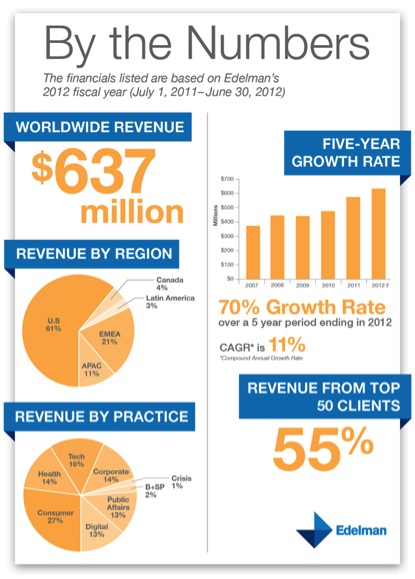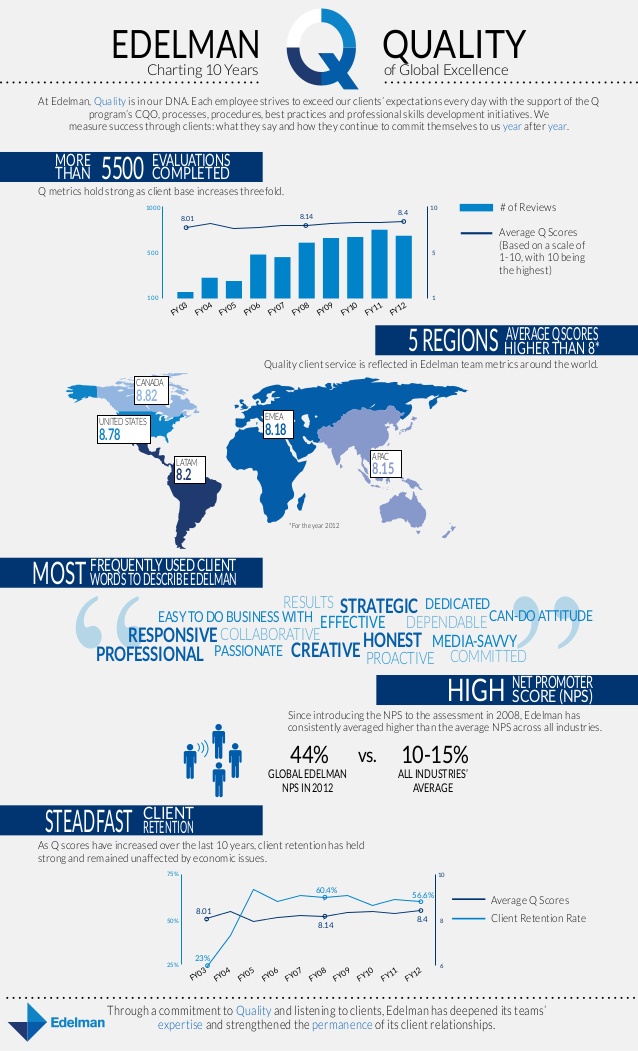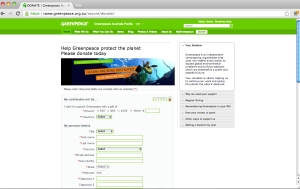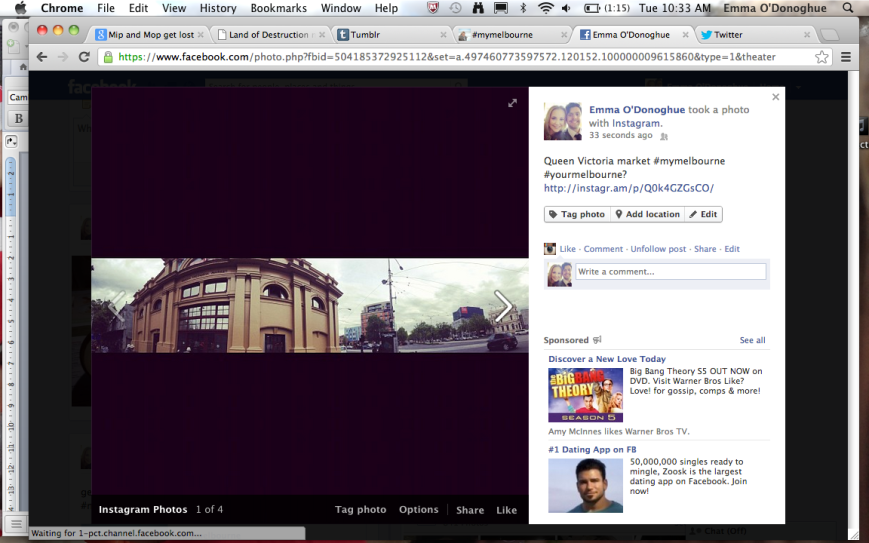Agency- Client Relationships
Agency- client relationships play an integral role in the operation and management of a PR agency or firm. Bruning and Ledingham (2002, p. 25) note the continual development and formation of agency- client relationships, ‘Just as individuals experience relationship phases…account executives suggested that agency personnel and their clients likewise experience identifiable phases as relationships are initiated, developed, maintained, evolve, and deteriorate’ .
The business of client relationships has been spoken about by researchers as one that is complex in nature due to the diversity of clients. A 2009 study aimed to, ‘develop these ideas towards a view of clients as relational, pluralistic, processual and constructed’ (Alvesson et al 2009, p. 261). To achieve success it is suggested that communications professionals must develop a deep understanding of the client and the importance of monitoring and maintaining relationships and their unpredictability, ‘there are likely to be actors and groups within the client firm that identify with the project and their client positions, people that are skeptical or hostile and those who are ambivalent’ (Alvesson et al 2009, p. 256).
Edelman
There is a certain complexity evident when discussing agency- client relationships and this complexity seems to be understood by global PR firm Edelman. Chia (2008, p. 69) suggests that, ‘Public relations is a profession where successful relationships are developed, maintained and effectively managed’ and Edelman’s emphasis on the unique nature of clients and tailoring appropriate relationships mirrors this idea. Dan Edelman established Edelman in 1952 and is now renowned for his work in the PR industry (Edelman 2013a). Edelman is the largest Public Relations firm, employing 4,800 communicators globally, with 67 offices worldwide (Edelman 2013a). Edelman represents a range of different clientele, including:
- Aerospace and Defense
- Consumer packaged goods
- Energy
- Financial Service
- Nonprofit
- Sports and Entertainment
- Retail
(Edelman 2013c)
(Source: http://www.edelman.com/what-we-do/industries/)
Chia’s (2008, p. 77) idea of ‘blending’, ‘best described the mix of a personal and business management approach as one being part of the other’ becomes very relevant in the case of Edelman as they address Chia’s notion of a personal and business management approach in their guiding principles:
- Edelman is committed to honesty.
- Edelman is committed to transparency.
- Edelman is committed to fair dealing.
- Edelman ensures business activity aligns with the interests of all stakeholders: clients, employees and parties with whom we interact.
- Edelman strives to model best practice in all areas of our business.
- Edelman does not violate legal obligations.
(Edelman 2013d)
(Source: http://www.edelman.com/who-we-are/about-edelman/values-and-mission/)
Edelman reported revenue of $637 million worldwide in 2012 (Figure 1). The organisation has the financial might to invest in programs and procedures to establish their intended actions in the area of agency-client relationships. Edelman is an agency that addresses Burgers (1972, p. 23) two basic requirements, ‘Having something valuable to say, and the ability to say it in a manner that will be listened to’ . As a result of Edelman’s extensive experience and financial strength they can be identified as a leader in the area of agency- client relationships.
Figure 1:
(Edelman 2013a)
(Source: http://www.edelman.com/who-we-are/about-edelman/the-details/)
Key Concepts
Due to Edelman’s 70% growth rate over a 5 year period ending in 2012 (Figure 1) and the company’s strong financial position, the organisation offers an example of successful billing, budgeting and financial management. Additionally in 2012 Adweek reported that in 2011 Edelman gained 100 new clients globally and only lost one major account, Burger King (Adweek 2012, para. 10). This high level of retention and acquisition leads to a discussion of the role client relationships has in improving client acquisition and retention. These two key concepts associated with agency- client relationships work autonomously, as well as in conjunction with one another to achieve Edelman’s tangible success.
Billing, Budgeting and Financial Management
In its book ‘Public Relations Business’ Entrepreneur Magazine (2012, p. 143) suggests, ‘One of the primary indicators of the overall health of your business is its financial status, and its important that you monitor your financial progress closely’ . Entrepreneur magazine’s idea offers an ideal introduction into discussing Edelman’s approach to financial management within relationship management. As Bruning and Ledingham (2002, p. 26) note the practicalities of financial management are key to establishing a prosperous ongoing relationship, ‘both the agency and the client are very cognizant of the value that is received as a result of participating in the relationship, and often view the initial phases of agency-client relationship development in a very utilitarian manner’ .
Edelman has a number of different strategies in place to ensure clients feel as though they are being provided with the best and fairest services. Firstly they are open and transparent with releasing their revenue and growth, it was reported in 2011 Edelman’s global revenue grew by 17 percent and they billed $456 million (Adweek 2012, para. 9). Clients and potential clients being able to access this sort of information contributes to Edelman establishing an image of strength and reliability. In addition Edelman projects itself as trustworthy in the area of financial management by having a key principle that addresses financial dealings with clients:
- Edelman is committed to fair dealing.
(Edelman 2013d)
(Source: http://www.edelman.com/who-we-are/about-edelman/values-and-mission/)
Secondly and probably most significantly Edelman has established a ‘Code of Ethics and Business Conduct’, the code of conduct addresses, ‘common compliance and ethics issues facing global businesses today and outlines the responsibilities we have to one another, to our clients and stakeholders, to the firm, and to our industry’ (DJE Holdings 2013, p. 2). Most notably the code of conduct addresses financial management, billing and budgeting in the following ways:
- The financial and accounting records of Edelman and its subsidiaries must be maintained in accordance with generally accepted accounting principles or international financial reporting standards (as appropriate) and implemented consistently throughout the organization.
- All employees must diligently follow Edelman’s policies and procedures and our client contractual provisions to ensure that we bill our clients appropriately
(DJE Holdings 2013, p. 17-19)
(Source: http://www.scribd.com/doc/96444691/Code-of-Ethics)
Specifically the ‘‘Code of Ethics and Business Conduct’ outlines the way hours should be correctly entered into the system, client’s invoices must reflect bill rates and business expenses must be reported accurately and then billed to the client appropriately. These measures support ‘Public Relations Business’ idea that it is a necessity to, ‘Establish and follow sound billing procedures from the beginning’ (Entrepreneur magazine 2012, p. 145). Edelman has put in place these procedures globally to the maintain the trust of clients, supporting Chia’s (2008, p. 69) suggestion that agency- client relationships are made up of a combination of both a personal and business management approach, ‘The business of relationships is about how they are managed and what makes them viable, effective and beneficial for business partners’ .
Client Acquisition and Retention
As mentioned earlier, in 2011 Edelman gained 100 new clients and only lost one major account (Adweek 2012, para 10). These sorts of statistics would suggest that the organisation understands the intricacies of client acquisition and retention.
The company adopts a number of different strategies to assist in this field. Firstly, what has been named a ‘client-centric approach’ to Public Relations that focuses on the ongoing needs of the client, ‘Because at our core, what we’re all about is successfully supporting every client, every day’ (Edelman 2013b). This statement addresses similar ideas to those of Brunner (2008, p. 74) who identifies, ‘trust, control mutuality, relationship commitment, and relationship satisfaction as the most important outcome factors in an organizational relationship…’ . Clients have most frequently described Edelman as:
- Strategic
- Dedicated
- Honest
- Creative
- Passionate
(see Figure 2)
Similarly Figure 2 provides evidence that despite economic issues client retention has remained steady over the past ten years.
Figure 2:
(Edelman 2012)
(Source: http://www.slideshare.net/EdelmanInsights/edelman-quality)
Secondly Edelman has implemented a ‘Global Client Relationship Management Program’ this program has been initiated for the companies largest clients and aims to use a global relationship management approach to achieve business success, ‘This client-centric approach ensures that all practices and offices around the world working on the client’s business follow consistent standards, protocols and processes – and achieve impactful results’ (Edelman 2013b). This sort of initiative allows Edelman to employ open, yet strategically structured and tailored communication to cover all areas of dialogue with a client, supporting Chia’s (2008, p. 79) research that, ‘Where communication was open, transparent and formal and informal dialogue, face-to-face or online communication was managed ethically, respect for all relational partners was evident’ .
In addition the acquisition of key clients in Edelman’s Australian offices recently highlights the global reach of Edelman’s policies and their substantial success:
Conclusion
By synthesizing the academic research and the values and actions of Edelman it is clear that Public Relations practitioners need to understand the complexity of agency- client relationships to achieve success. In the area of financial management, billing and budgets it can be concluded that by providing clear, sound and understandable information an organisation can develop a level of respect from clients, in order to achieve Bruning and Ledingham’s (2002, p. 28) ideal state of agency- client relationship, ‘Moreover, both parties are able to accurately predict the behavior of the other, and have developed highly complex patterns of interaction’ . In the area of client acquisition and retention it can be concluded that by valuing, understanding and listening to a client an organisation can achieve success. This conclusion is in line with the research of Burger (1972, p. 24) who suggests that, ‘Like most of us, clients or employers are perfectly willing to listen to sage counsel, and perfectly willing to accept valid ideas, as long as such listening or acceptance does not imply that they are fools’ .
Reference List:
Adweek 2012, ‘Media Agency of the Year: PR, Edelman’, Adweek, 23 January, viewed 15 September 2013, < http://www.adweek.com/news/advertising-branding/media-agency-year-pr-edelman-137643>
Alvesson, M, Karemann, D, Sturdy, A, Handley, K 2009, ‘Unpacking the client(s): Constructions, positions and client—consultant dynamics’, Scandinavian Journal of Management, vol. 25, pp. 253-263.
Bruning, S, Ledingham, J 2002, ‘Identifying the Communication, Behaviors, and Interaction Patterns of Agency-Client Relationships in Development and Decline’, Journal of Promotion Management, vol. 8, no. 2, pp. 21-34.
Brunner, B 2008, ‘Listening, Communication & Trust: Practitioners’ Perspectives of Business/Organizational Relationships’, International Journal of Listening, vol. 22, no. 1, pp. 73-82.
Burger, C 1972, ‘The New Challenges in Client Relationships’, Public Relations Quarterly, vol. 12, no. 2, pp. 22-25.
Chia, J 2008, ‘The business of relationships’, Asia Pacific Public Relations Journal, vol. 9, pp. 69-86.
Edelman 2012, Edelman Insights: Edelman Quality, Edelman, viewed 15 September 2013, < http://www.slideshare.net/EdelmanInsights/edelman-quality>
Edelman 2013, About Us: The Details, Edelman, viewed 15 September 2013, <http://www.edelman.com/who-we-are/about-edelman/the-details/>
Edelman 2013, Client-Centric Approach, Edelman, viewed 15 September 2013, <http://www.edelman.com/who-we-are/about-edelman/our-global-approach/>
Edelman 2013, Industries, Edelman, viewed 15 September 2013, <http://www.edelman.com/what-we-do/industries/>
Edelman 2013, Values and Mission, Edelman, viewed 15 September 2013, <http://www.edelman.com/who-we-are/about-edelman/values-and-mission/>
DJE Holdings 2013, The Edelman Family of Companies: Code of Ethics and Business Conduct, Edelman, viewed 15 September 2013, <http://www.scribd.com/doc/96444691/Code-of-Ethics>
Entrepreneur magazine 2012, ‘Financial Management’, in Public Relations Business: Entrepreneurs Step-by-Step Startup Guide, Entrepreneur Press, viewed 15 September 2013, <http://reader.eblib.com.au.ezproxy.lib.rmit.edu.au/(S(lebbx1ldp3bycdednfdarmjw))/Reader.aspx?p=979548&o=116&u=IOscgPs%2fwrrXl%2bHlhzQrww%3d%3d&t=1379833714&h=B0F2DDEAFD3C56FDC4E57DF9C713FAC60A3373F2&s=10104592&ut=337&pg=1&r=img&c=-1&pat=n#>
PRIA 2012, Edelman joins KFC at the dinner (and boardroom) table, PRIA, viewed 15 September 2013, <http://www.pria.com.au/industrynews/edelman-joins-kfc-at-the-dinner-and-boardroom-table>
PRIA 2010, Edelman wins the EXTRA professional account, PRIA, viewed 15 September 2013, <http://www.pria.com.au/news/id/1032>
PRIA 2010, Edelman wins Listerine, PRIA, viewed 15 September 2013, <http://www.pria.com.au/news/id/1038>















